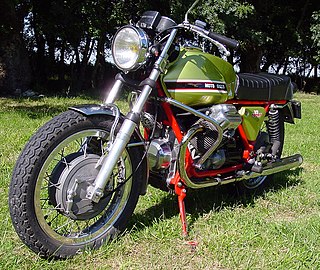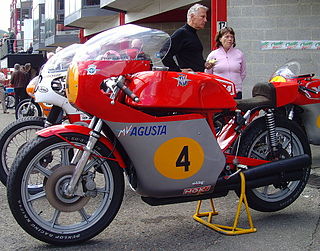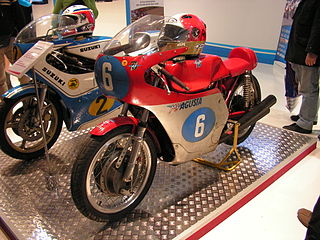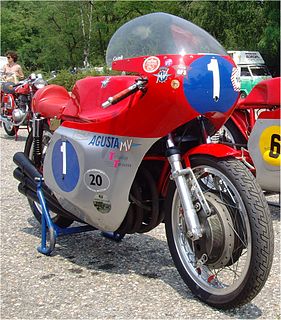Related Research Articles

MV Agusta is a motorcycle manufacturer founded by Count Domenico Agusta on 19 January 1945 as one of the branches of the Agusta aircraft company near Milan in Cascina Costa, Italy. The abbreviation MV stands for Meccanica (mechanics) Verghera, the hamlet where the first MVs were made. The modern headquarters and main production facilities are located in Varese, Italy on the shore of Lake Varese.

FB Mondial is a motorcycle manufacturer, founded in 1929, in Milan, Italy. They are best known for their domination of Motorcycle World Championships between 1949 and 1957. The firm produced some of the most advanced and successful Grand Prix road racers of the time, winning five rider and five manufacturer World Championships in that short period.

Carlo Ubbiali was an Italian nine-time World Champion motorcycle road racer. In the 1950s, he was a dominant force in the smaller classes of Grand Prix motorcycle racing, winning six 125cc and three 250cc world titles.
The 1957 Isle of Man Tourist Trophy was the Golden Jubilee event and the second race in the 1957 Motorcycle World Championships.

Tarquinio Provini was an Italian professional Grand Prix motorcycle road racer. He was a two-time world champion in road racing. Provini was also a four-time Isle of Man TT winner and won 13 Italian national championships.
Cecil Charles Sandford is a British former professional Grand Prix motorcycle road racer. He competed in the FIM motorcycle Grand Prix world championships from 1950 to 1957. Sandford is a two-time FIM road racing world champion and a two-time winner at the Isle of Man TT.

The MV Agusta 500cc Three (1965-1973) or MV Agusta Tre was a road racing motorcycle produced by the Italian manufacturer MV Agusta to compete in the 500 cc Grand Prix motorcycle racing World Championship. The motorcycle was introduced in 1966 to compete against the ever competitive Honda racing machines and was a bored out version of MV Agusta's highly successful 350 cc three cylinder. Giacomo Agostini won consecutive world championships in the 500 cc class with this motorbike from 1966 to 1972. In addition, MV Agusta won the Constructors' World Championships from 1967 to 1972. The MV Agusta Tre is considered the most successful racing motorcycle in history.

Lino Tonti was an Italian motorcycle engineer known for designing a number of sport and racing motorcycles in the 1950s and 1960s, and for creating his signature 'Tonti frame' for Moto Guzzi's 1971 V7 Sport, setting his stamp on all Moto Guzzis since.

The MV Agusta 500cc road racers were motorcycles that the manufacturer MV Agusta built and which were used to compete in 500cc Grand Prix motorcycle racing series between 1950 and 1976. 18 500cc world championship titles were achieved with these machines ridden by John Surtees, Gary Hocking, Mike Hailwood, Giacomo Agostini and Phil Read between 1958 and 1974.

The MV Agusta 500 6 cilindri was a prototype racing motorcycle built by the Varese company MV Agusta in 1957. Only one prototype was made.

The MV Agusta 350 cc racers were motorcycles produced by MV Agusta between 1954 and 1976 and raced in the 350 cc motorcycle GP championships. 10 world titles were achieved by riders John Surtees, Gary Hocking and Giacomo Agostini on these machines.

The MV Agusta 350 6 cilindri was a prototype racing motorcycle built by the Varese company MV Agusta in 1957, for the 350 cc class of the FIM Motorcycle World Championship. The project was resurrected in 1968. Neither version was ever used in a race. The only surviving model is now in the MV Agusta factory museum.
The MV Agusta 250 Bicilindrica was a 250 cc factory racing motorcycle manufactured by the Italian brand MV Agusta from 1957 to 1961. With this machine 11 GPs, 2 Driver Championships and 2 manufacturers World Championships were won.
The MV Agusta 203 Bialbero and MV Agusta 220 Bialbero were Italian factory racing motorcycles made by MV Agusta to compete in the 1955 250 cc World Motorcycle Racing Championship. The machine won three GPs and with it MV Agusta won that year's 250 cc Constructors Championship.

The MV Agusta 175 were a series of motorcycles produced by the Italian manufacturer MV Agusta from 1953 to 1960. The series included touring, GT, sports and supersports models. There were also two racing variants. Because of the shape of the petrol tank, the sports and supersport models became known as the Disco Volante. The series was MV's best seller.

The MV Agusta 125 Bialbero was a 125 cc factory racer from the Italian brand MV Agusta, which was used between 1950 and 1960. The machine won 34 GPs, 6 rider's championships and one manufacturer's championship. The machine also won 4 Italian Championships and 10 National Championships in other countries.

The MV Agusta 125 Pullman was a motorcycle produced by the Italian manufacturer MV Agusta from 1953 to 1956. The model achieved a good sales success, and had the highest production of any machine from MV Agusta. Many brought the bike as the only means of family transport or as a work vehicle. Despite the questionable aesthetics, the Pullman offered a comfortable ride, derived by the driving position, soft suspension and large section tires. This was particularly appreciated by users, so much so that they were imitated by some competitors. 27,000 machines of this model series were produced. The model was also produced under licence in Spain by Avello, where it was marketed as the MV Avello 125 Pullman Turismo.
Arturo Magni was an Italian engineer racing team manager and entrepreneur.
Piero Remor was an Italian engineer and motorcycle constructor, best known for his work for the Gilera and MV Agusta brands.
References
- 1 2 3 4 5 "MV Agusta Corse 203 - 220 - 250 Monocilindrica 1955-1959". www.mv-agusta-club.de (in German). MV Agusta Club Deutschland. Retrieved 18 June 2019.
- 1 2 3 "motogp.com · 250cc World Standing 1956". www.motogp.com. Retrieved 18 June 2019.
- 1 2 "motogp.com · 250cc World Standing 1958". www.motogp.com. Retrieved 18 June 2019.
- 1 2 3 "Overwinningen". www.mvagustaoldtimers.nl (in Dutch). MVagusta-Oldtimers. Retrieved 18 June 2019.
- ↑ "motogp.com · 250cc World Standing 1955". www.motogp.com. Retrieved 18 June 2019.
- ↑ Cook 1957.
- ↑ Cook 1956.
- ↑ "Rupert Hollaus". www.motorsportmemorial.org. Motorsport Memorial. Retrieved 18 June 2019.
- ↑ "motogp.com · 125cc World Standing 1952". www.motogp.com. Retrieved 18 June 2019.
- ↑ The Motor-Cycle dated 13 June 1957.
- ↑ "Roberto Colombo". Motorsport Memorial. Retrieved 18 June 2019.
- ↑ "John Hartle career statistics". motogp.com. Retrieved 18 June 2019.
- ↑ "motogp.com · 250cc World Standing 1957". www.motogp.com. Retrieved 18 June 2019.
- ↑ "History of the MotoGP". Devitt Insurance. Retrieved 18 June 2019.